"Ask the Coach" is the column in which Wolfgang Unsöld answers your questions. The book of the same name was published by Riva Verlag and Available right here on Amazon.
Question: As a trainer, you have certainly tested many methods for optimizing regeneration. In your experience, what are the best, least common recovery optimization methods, regardless of budget? Tom H
WU: The Optimizing regeneration is a broad field. In addition to listening to protein consumption, a post-workout shake and better quality and quantity of sleep as far as my basic recommendations for improving regeneration are concerned, I have tested dozens of methods and tools over the past 10 years. Especially regardless of the budget, the first thing that comes to mind is FSM, which stands for Frequency Specific Microcurrent. In January 2010 I attended a seminar with physiotherapist Nicholas Liatsos in the USA and there I came into contact with an FSM unit for the first time. After the seminar, I was so enthusiastic about the first results, which were immediately noticeable, that I immediately ordered my own FSM unit and it is still in use today. I occasionally recommend the purchase to trainers and customers, but with an investment of approx. 3500 USD including programming, this is in the upper segment and therefore not my first or second recommendation.
What is FSM?
FSM stands for Frequency Specific Microcurrent and has been used in sports medicine in the USA for many years. FSM Units are specially programmed TENS devices. TENS stands for transcutaneous electrical nerve stimulation . Unlike TENS devices, which are primarily used in alternative medicine for pain therapy, FSM is also used in sports medicine, to increase muscle strength, to optimize muscle soreness (DOMS), as well as for functional disorders of the stomach and intestines, optimization of regeneration and modulation of the nervous system.
What is microcurrent?
Microcurrent - one-millionth of an ampere - is a current of the magnitude of the currents that exist between and within the cells of our body.
Effects of microcurrent on ATP production
ATP - short for adenosine triphosphate - is the universal and direct energy carrier of every cell. In 1982, Ngok Cheng published a study on the effect of electric currents on ATP production, protein synthesis and membrane transport in rat skin. There was a 500% increase in ATP synthesis, an increased amino acid transport into the cell by 70 percent and an increased transport of degradation products by 40 percent.
Effects of microcurrent on cytokines
Another mechanism of action of the FSM seems to be the influence of micro currents of certain frequencies on cell metabolism and cytokines.
What are cytokines?
Cytokines play a crucial role in the immune system, especially in inflammatory responses, as they have a specific role in cell interaction and communication.
A distinction is made between pro-inflammatory cytokines and anti-inflammatory cytokines.
Pro-inflammatory cytokines - Pro-inflammatory cytokines such as interleukin 1, 6 and 10, and tumor necrosis factor alpha can be detected in a wide variety of pain conditions such as muscle soreness.
Anti-inflammatory cytokines - Anti-inflammatory cytokines such as interleukin 10 and 4 are antagonists of the pro-inflammatory cytokines.
The effect of microcurrent treatment with specific frequencies is based on the studies and work of Dr. Carolyn McMakin on suppression of pro-inflammatory cytokines and stimulation of anti-inflammatory cytokines.
The effects of the FSM can be summed up as a modulation of cell signals.
These effects - on ATP, amino acid transport and cytokines - are crucial to optimizing post-workout recovery. In particular, the FSM Unit's post-workout protocol is one of the best tools I use to improve recovery quickly and noticeably.
FSM is still largely new territory in Europe, even in competitive sports, whereas in US professional leagues such as the NFL and NHL, optimizing performance via FSM has been successfully established for over 10 years and is one of the further standard measures.
Excellent further reading on this is the work of Dr. Robert Becker, who explains the bioelectrical nature of human cells in his book The Body Electric and the work of Dr. James Oschman, who describes the biophysics of energy medicine in his book Energy Medicine - The Scientific Basis .
Good luck with FSM!
Image: The FSM Custom Care Unit I use.

